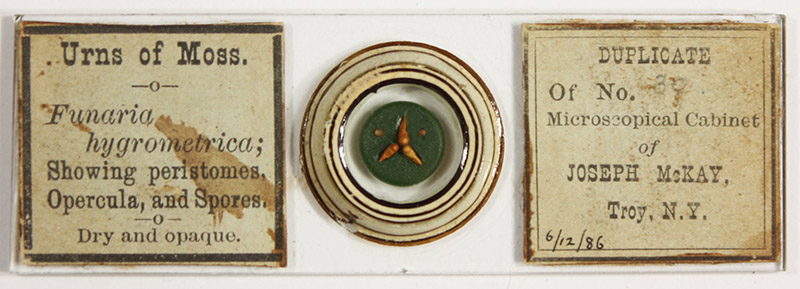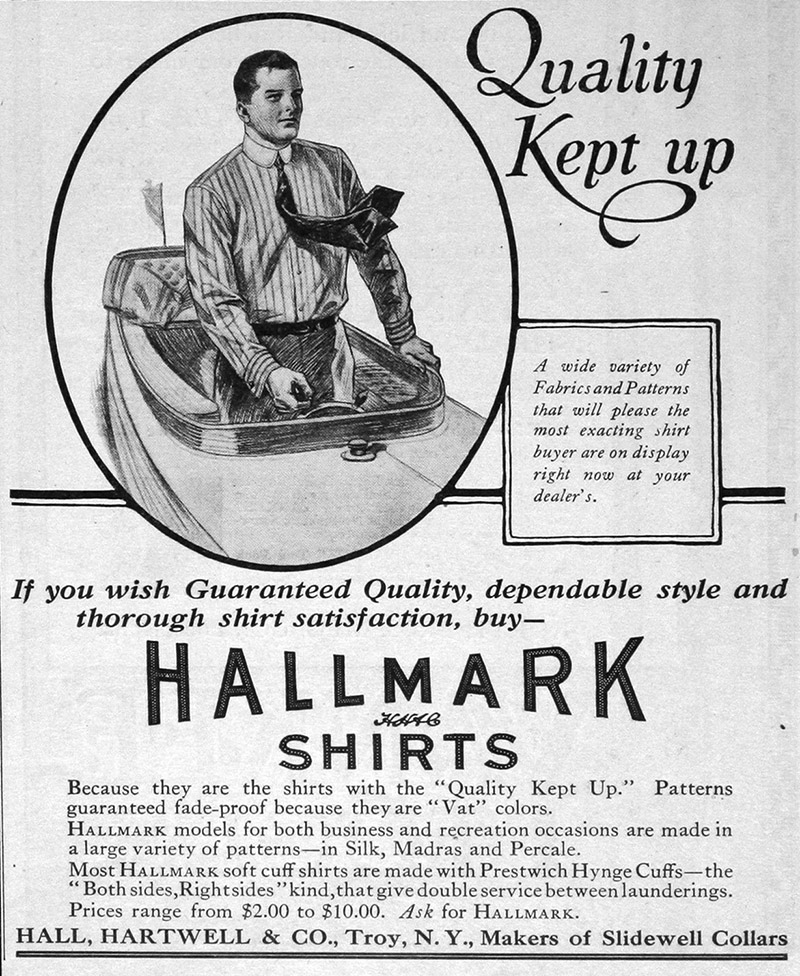Joseph McKay, 1854 - 1941
by Brian Stevenson
last updated April, 2020
Joseph McKay caught the microscopy “bug” when in his early twenties, and his enthusiasm persisted long into his later years. He was an early member of the Troy Scientific Association, a member of the American Society of Microscopists, and a long-serving officer in the American Postal Microscopical Club.
McKay produced microscope slides for exchange from ca. 1877 onward. Relatively scarce nowadays, his known slides are very well made, with artistic construction and professionally printed labels (Figures 1-2).

Figure 1.
An 1886 slide of reproductive components of Funaria hygrometrica, by Joseph McKay. It is dated 1886 in handwriting. Labeled “duplicate’, it was presumably made for exchange with a colleague. This moss species was evidently a major interest of McKay’s, as he advertised exchanges of this specimen as early as 1878 (Figure 3).

Figure 2.
Oblique view of the McKay slide that is shown in figure 1. It is a very deep mount. The rounded appearance of the mounting cell suggests that it was made from a metal ring that was covered with cement and paint. Notably, in 1878 “Mr. Joseph McKay gave a demonstration of Prof. H.L. Smith’s method of dry mounting by means of a background of wax and a curtain-ring cell, showing the facility and elegance with which this method may be carried out”, (The American Journal of Microscopy and Popular Science).

Figure 3.
Exchange offers from Joseph McKay that were published in The American Journal of Microscopy and Popular Science. I have not found any later exchange advertisements, suggesting that McKay’s connections through the Troy Scientific Association, the American Society of Microscopists, and the American Postal Microscopical Club might have been sufficient for him to acquire novel specimens.
Joseph McKay was born during February, 1854, in Troy, New York, the first child of Robert and Charlotte McKay. The parents were recent émigrés, Robert from Ireland and Charlotte from Scotland. At the time that Joseph was born, his father was working as a “chair maker”. Around 1867, Robert McKay became sexton of the Second Street Presbyterian Church of Troy. That may or may not have been a full-time job; the 1875 New York census listed Robert’s occupation as “chair maker”.
Joseph had a serious, outside job by the time he was only 13-14 years old: the 1868 City Directory of Troy listed him as a “clerk” for a mercantile business. By 1874, he was working as a “book keeper” for a lumber mill.
McKay first published an offer to exchange microscope slides in early 1877 (Figure 3). A year later, he gave a demonstration on mounting methods to the Microscopical Section of the Troy Scientific Association. I did not locate a record of when McKay joined that society, but his evident expertise in slide-making by 1877 suggests that he had been a member for quite some time before then. McKay soon became an officer of the society.
Joseph McKay also joined the American Postal Microscopical Club during the 1870s. Fundamentally the same as the UK’s Postal Microscopical Society, this group assembled boxes of 6 interesting slides that were mailed from member-to-member through a circuit. By 1879, McKay was serving as Corresponding Secretary and Treasurer, and he held offices in the club for many years afterward. He was a frequent contributor of slides to the circuits, which likely resulted in offers to exchange specimens with microscopists throughout the US. He joined the American Society of Microscopists in 1884, which would also have provided contacts for exchanges.
Around 1879, McKay began work as foreman of the laundry section of Miller, Hall, and Hartwell, a manufacturer of shirts, cuffs, and collars. Troy was a major center for such apparel, and came to be known as “The Collar City”. The 1880 census shows that two of Joseph’s sisters also worked for Miller, Hall, and Hartwell: 23 year-old Martha as a “collar maker”, and 17 year-old Margaret as a “laundress”.
Coinciding with what was probably a well-paid, stable job, Joseph married Abbie Uline. The couple moved in with Abbie’s widowed mother. They had two children over the years.
McKay invented a machine for starching shirt collars and cuffs, acquiring patents in 1892 (Figure 4). As with so many industrial machines, McKay’s starcher increased production rates while reducing expenses by requiring fewer employees. Moreover, the employees did not need to have the skills previously required for hand ironing and starching, so wages plumetted. During a strike in Troy during 1893, union representatives stated, “The McKay starching machine was introduced as a means of reducing wages. We recognized it as being of no material assistance to a starchery. We therefore refused to accept the reduction of fifty-six per cent in our wages occasioned by the introduction of the machine”.
Likely a consequence of profits from his invention, McKay bought a partnership in his employer’s business, which became Hall, Hartwell & Company (Figure 5). He retired around 1930.
From records I located, McKay remained an active microscopist until the end of his life. He died on February 14, 1941.

Figure 4.
A McKay Collar and Cuff Starcher, from D.H. Benjamin’s “The Launderer”, 1900.

Figure 5.
Entries from the 1902 “Troy City Directory”. Joseph McKay was a member and officer of the American Postal Microscopical Club for many years. McKay as one of the owners of Hall, Hartwell & Co., as noted in their listing. The bottom excerpt is a paid advertisement.

Figure 6.
A circa 1920 advertisement from McKay’s company.
Resources
The Albany and Troy Society Blue Book (1917) McKay, Mr. and Mrs. Joseph, page 101
The American Journal of Microscopy and Popular Science (1877) Exchange offer from Joseph McKay, Vol. 2, January issue
The American Journal of Microscopy and Popular Science (1878) Microscopical Section, Troy Scientific Association, Vol. 3, page 93
The American Journal of Microscopy and Popular Science (1878) Exchange offers from Joseph McKay, Vol. 3, page 264 and others
The American Journal of Microscopy and Popular Science (1879) American Postal Microscopical Club, Vol. 4, pages 185-186
The American Monthly Microscopical Journal (1888) Vol. 9, page 155
The American Monthly Microscopical Journal (1889) Troy Scientific Association, N.Y., Vol. 10, page 94
The American Monthly Microscopical Journal (1890) Report upon the Postal Club Boxes, Vol. 11, pages 33-34
Annual Report of the Bureau of Statistics of Labor of the State of New York (1893) Laundry employees, Troy, pages 37-38
Benjamin, Dana H. (1900) The Launderer. A Practical Treatise on the Management and the Operation of a Steam Laundry, The Starchroom Publishing Co., Cincinnati, pages 37-40
Congressional Serial Set (1892) page 240
Corsaro, James S., and Kathleen D. Roe (2015) Labor and Industry in Troy and Cohoes: A Brief History, https://www.albany.edu/history/Troy-Cohoes
The Naturalists' Directory (1877) page 23
The Naturalists' Directory (1883) page 76
The Naturalists' Directory (1896) page 133
The Naturalists' Directory (1919) page 107
Proceedings of the American Society of Microscopists (1884) Vol. 6 page 269
Transactions of the American Microscopical Society (1909) Members, Vol. 29, page 198
Troy, New York, City Directory (1859 - 1902)
The Troy Record Almanac and Year-book (1914) Troy Scientific Association, page 497
Turbin, Carole (1994) Working Women of Collar City: Gender, Class, and Community in Troy, New York, 1864-86, University of Illinois Press, Champaign, Illinois
Turbin, Carole (2013) Reconceptualizing family, work and labor organizing: Working women in Troy, 1860-1890, in The Intersection of Work and Family Life, edited by Nancy F. Cott, K.G. Sauer, Munich, pages 167-182
US census and other records, accessed through ancestry.com
Weise, Arthur J. (1886) The City of Troy and Its Vicinity, E. Green, Troy, New York, page 305





